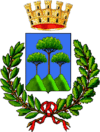Somma Vesuviana
| Somma Vesuviana | ||
|---|---|---|
| Comune | ||
 | ||
| ||
 Somma Vesuviana Location of Somma Vesuviana in Italy | ||
| Coordinates: 40°52′21″N 14°26′13″E / 40.87250°N 14.43694°E | ||
| Country | Italy | |
| Region | Campania | |
| Metropolitan city | Naples (NA) | |
| Frazioni | Somma, Mercato Vecchio, Casamale, Rione Trieste, Santa Maria del Pozzo, Starza della Regina, San Sossio | |
| Government | ||
| • Mayor | Pasquale Piccolo | |
| Area | ||
| • Total | 30.74 km2 (11.87 sq mi) | |
| Elevation | 165 m (541 ft) | |
| Population (April 2015) | ||
| • Total | 35,328 | |
| • Density | 1,100/km2 (3,000/sq mi) | |
| Demonym(s) | Sommesi | |
| Time zone | UTC+1 (CET) | |
| • Summer (DST) | UTC+2 (CEST) | |
| Postal code | 80049 | |
| Dialing code | 081 | |
| Patron saint | St. Januarius | |
| Saint day | September 19 | |
| Website | Official website | |
Somma Vesuviana is a town and comune in the Metropolitan City of Naples, Campania, southern Italy.
History
Before the Roman colonisation, the area of today's Somma Vesuviana was probably inhabited by Italic peoples like Samnites and Oscans.
Later it became a vacation place for the rich patricians of Rome, who built magnificent villas in the area.
A villa was discovered in the 1930s in the frazione of Starza della Regina, and interpreted at the time as that of emperor Augustus at Nola where he probably passed his last days of life.[1]
In 2002 excavations on the villa started again which determined that the villa was buried during the eruption of Vesuvius of 472 AD[2] and not 79 AD (like that which buried Pompeii etc.), and so was part of the community that continued after the earlier eruption and recovered better than the territories to the south. Much of the villa has been brought to light with its rich decoration.[3]
Roman Baths in nearby Pollena Trocchia were also discovered in 1988 and subsequently exposed.
Main sights
- The ancient quarter of Casamale has walls of Aragonese times.
- The Collegiata church
- Church of San Domenico
- Church of Santa Maria del Pozzo (15th century). Its cloister is home to a museum of the peasant culture of the area.
- Palazzo de Felice, a 16th-century palace and ancestral home of the de Felice family.
References
- ↑ Suetnonius, Augustus, 98-100
- ↑ Journal of Volcanology and Geothermal Research Volume 113, Issues 1–2, 15 March 2002, Pages 19–36, The 472 AD Pollena eruption of Somma-Vesuvius (Italy) and its environmental impact at the end of the Roman Empire
- ↑ http://www.apollineproject.org/index.html

